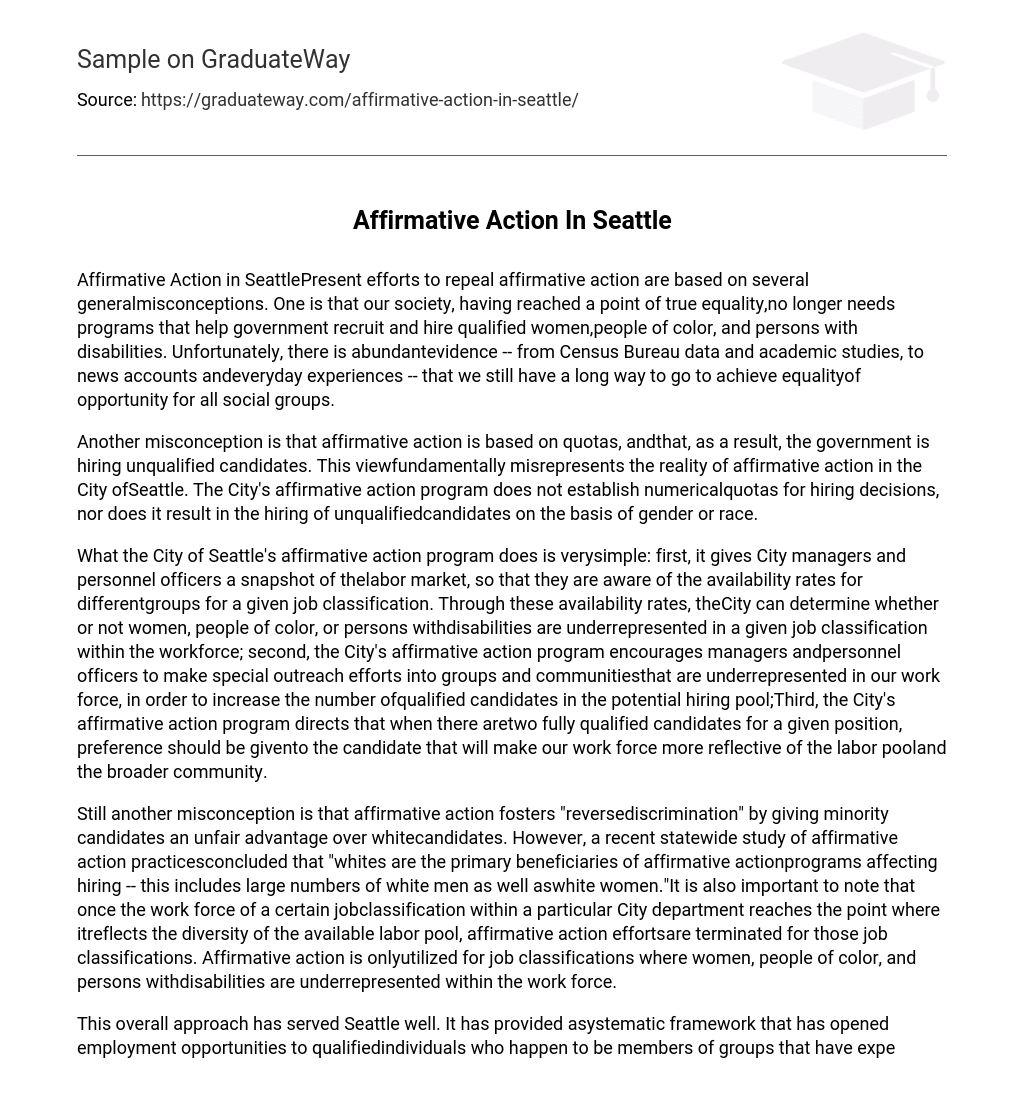Affirmative Action in SeattlePresent efforts to repeal affirmative action are based on several generalmisconceptions. One is that our society, having reached a point of true equality,no longer needs programs that help government recruit and hire qualified women,people of color, and persons with disabilities. Unfortunately, there is abundantevidence — from Census Bureau data and academic studies, to news accounts andeveryday experiences — that we still have a long way to go to achieve equalityof opportunity for all social groups.
Another misconception is that affirmative action is based on quotas, andthat, as a result, the government is hiring unqualified candidates. This viewfundamentally misrepresents the reality of affirmative action in the City ofSeattle. The City’s affirmative action program does not establish numericalquotas for hiring decisions, nor does it result in the hiring of unqualifiedcandidates on the basis of gender or race.
What the City of Seattle’s affirmative action program does is verysimple: first, it gives City managers and personnel officers a snapshot of thelabor market, so that they are aware of the availability rates for differentgroups for a given job classification. Through these availability rates, theCity can determine whether or not women, people of color, or persons withdisabilities are underrepresented in a given job classification within the workforce; second, the City’s affirmative action program encourages managers andpersonnel officers to make special outreach efforts into groups and communitiesthat are underrepresented in our work force, in order to increase the number ofqualified candidates in the potential hiring pool;Third, the City’s affirmative action program directs that when there aretwo fully qualified candidates for a given position, preference should be givento the candidate that will make our work force more reflective of the labor pooland the broader community.
Still another misconception is that affirmative action fosters “reversediscrimination” by giving minority candidates an unfair advantage over whitecandidates. However, a recent statewide study of affirmative action practicesconcluded that “whites are the primary beneficiaries of affirmative actionprograms affecting hiring — this includes large numbers of white men as well aswhite women.”It is also important to note that once the work force of a certain jobclassification within a particular City department reaches the point where itreflects the diversity of the available labor pool, affirmative action effortsare terminated for those job classifications. Affirmative action is onlyutilized for job classifications where women, people of color, and persons withdisabilities are underrepresented within the work force.
This overall approach has served Seattle well. It has provided asystematic framework that has opened employment opportunities to qualifiedindividuals who happen to be members of groups that have experienced long-standing and persistent discrimination. A review of the City’s work forceprofiles since the Civil Rights Act of 1964 clearly illustrates the dramatic andpositive impact affirmative action has had on providing equal opportunities formore women, people of color, and persons with disabilities.
For example, in 1970, white workers represented an overwhelming 92.1percent of the City’s overall work force, while African Americans, Asians,Hispanics, and Native Americans combined represented only 7.9 percent of allCity employees. By 1980, the percentage of ethnic minority workers in the Citywork force had risen to 20.1 percent, and by June, 1994, the percentage ofpeople of color in the City work force reached 31.6 percent.
Moreover, during the past five years, the percentage of top Cityofficials and administrators has increased for all minority groups. Therepresentation of top officials and administrators who are African American hasmore than doubled over the past five years alone, rising from 8.2 percent to16.6 percent. The representation of women among top officials and administratorshas risen by roughly 30 percent, from 28.2 percent to 36.3 percent.
Finally, the City has exceeded its procurement utilization target fordirect voucher and blanket contracts for Minority owned Business Enterprises(MBE).The City is currently achieving 5.58 percent for MBE contracts, well abovethe 5 percent target.
As a result of these accomplishments, the City of Seattle has beenrecognized as a national leader and model in affirmative action, EqualEmployment Opportunity, and diversity. Most recently, in March, 1995, the City’sCultural Diversity Program received the City Cultural Diversity Award from theNational Black Caucus of Local Elected Officials.
Despite these very positive accomplishments, there is still much to bedone. In certain job classifications, and for certain demographic groups, Cityemployment does not yet fully represent the diversity of the community and thelocal labor pool. Indeed, women, people of color, and persons with disabilitiescontinue to be underrepresented within the City work force, and Women ownedBusiness Enterprises (WBE) currently receive only 4.47 percent of directvouchers and blanket contracts, far below the 12 percent target.
For this reason, we must continue to use affirmative action programs as ameans towards inclusion, eroding the very real barriers of bias that continue toblock many Seattle residents from reaching their full potential. Affirmativeaction stands as a powerful symbol of our firm commitment to equal opportunityfor all. It also affirms the City’s commitment to respect and value the manytalents, skills, and unique perspectives of the community’s diverse population.
In today’s society, there are two ways for a person to be included asbeing accepted or tolerated. But the reasons that AFFIRMATIVE ACTION uses aretoo narrow in their focus and only hurt those which it tries to help. Societyneeds to rid the problem not increase the effects. For example, AFFIRMATIVEACTION simply makes up for past losses. The diversity of problems and necessaryreimbursements are too much for an American society to try to take on at a timethat the deficit is at an all time high. One more addition to the fire is justtoo much. Since the passage of 1994 additions to the Civil Liberties Act, allthat the American society has been concerned with is the discrimination. Theproblem that all Americans are ignoring, is the blatant fact that every issue infavor of AFFIRMATIVE ACTION is based on a pat experience generally notexperienced by the person crying for assistance. The only good that comes withAFFIRMATIVE ACTION is the good it has served, and now it has overstayed itswelcome.





